
The Future Library: why you'll have to wait 98 years to read David Mitchell's new book

On a drizzly day earlier this year, the novelist David Mitchell walked into Nordmarka forest on the outskirts of Oslo, and prepared to bury his latest work.
There was just the right amount of rain, he later said; “graceful rain”. Half a mile into the woods, he came to a clearing where about 100 people had gathered. The local foresters had made a fire, brewed some coffee, and tied a small red ribbon around each of one thousand knee-high saplings to indicate that they were not to be harmed.
Though the audience included small children, it is unlikely that any of them will be beneficiaries of the strange legacy this ceremony was designed to mark. In order to picture the result, it is necessary to imagine at least one unborn generation further.
Mitchell’s book – a 90-page novella about which we can know no more than the title – will be kept hidden for 98 years, and only published when the trees, having reached maturity, can provide the paper on which to print it.
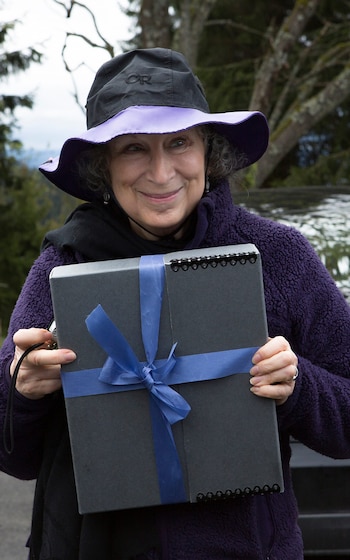
Mitchell is the second author of a hundred who will be part of Future Library, a project conceived by the Scottish artist Katie Paterson. The first was Margaret Atwood, who delivered her manuscript, Scribbler Moon, last year in a grey archival box wrapped in purple ribbon. The third writer in the sequence has just been announced: Sjón, the Icelandic author known for his collaborations with Björk as well as his historical and fabulist novels.
“The trees are coming into leaf/ Like something almost being said,” Mitchell read, quoting Philip Larkin in the forest. A choir sang, and as the voices echoed through the trees, Mitchell lifted the walnut box he’d had made for his manuscript. On its lid was an impression of his own hand, cast in silver. (He liked to think of the box as a cryogenic chamber, “amply worth the effort” given the century his book would spend in it.)
He announced the title – From Me Flows What You Call Time, taken from a piece of music by the Japanese composer Toru Takemitsu – and as he passed the box to Paterson, his handprint caught the light.
When I first heard about Future Library some years ago, I assumed it was some kind of hoax. Katie Paterson was proposing to ask a different author to write a brand new book each year for 100 years. Well, she couldn’t ask all of them, because at some point she herself would be dead, but that was the project.
None of these books would be read until 2114, at which point all 100 would be published. The authors would be sworn to secrecy about their contents. In the meantime, Paterson would plant enough trees to print the books when the time came to unearth them.
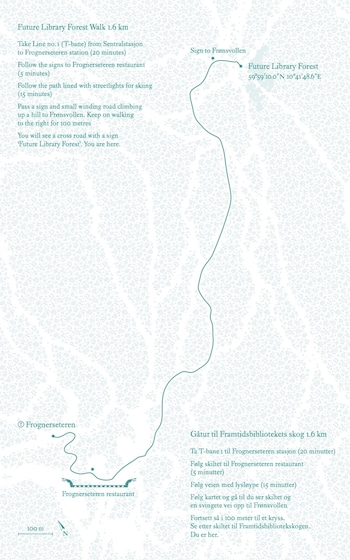
How could such a promise possibly be kept?
It was hard to imagine 100 writers not wanting to be read in their lifetime. On the other hand, perhaps Future Library was a ticket to posterity – a guarantee that one’s work would be relevant a hundred years from now. (This is what Mitchell now describes as the project’s “cocktail of vanity and humility”.)
If it were you, would you submit your best book, or your worst? When would the ink start to fade? Could the manuscripts be stolen? And how would we know if any of it had worked, when none of us would be alive to see the results?
Yet now the library has begun; it can already be partially indexed, if not borrowed from. Atwood, Mitchell, Sjón and Paterson all have more imagination than I did. That goes without saying – they are novelists and artists. But they also have more faith in the future. And that, perhaps, is worth pausing over.
Mitchell suggests that Future Library is “a vote of confidence in civilisation”. He didn’t know what to make of the project either, at first: “I wasn’t sure how for real it was,” he says. But when encouraged by Simon Prosser, the publisher responsible for bringing out the work of Ali Smith, Zadie Smith and Jonathan Safran Foer among others (and a member of the Future Library trust, charged with delivering the project to completion) he saw it as an opportunity to “put your money where your mouth is”.

Writing a book for a future library was a way to express the belief, as Mitchell puts it, that “things that are important to me will still exist, and that the orchestral blast of bad news that you get when you open newspapers and click on websites – all the dystopian stuff about climate change, about terrorism, about demagogues seizing control of large, industrial countries – that that side won’t win.
The side that values reading, that values seeing things from other people’s point of view, which is a great forte of the novel – that currently deeply embattled side has an equal shot at influencing the future.” Here, he says, was “a tiny way for me to do a little bit more than hoping.”
The idea first came to Katie Paterson many years ago while drawing tree rings on a piece of paper. “Very quickly, I saw chapters, and leaves of the book, a forest that prints a book, but that grows through time,” she says.
Paterson, whose work has been shown at the Hayward Gallery and Tate Britain, is broadly concerned with landscape, space and time, “human time, cosmic time, geological time,” as she puts it. She has designed a lightbulb that simulates moonlight; worked with DNA researchers to create a fossil necklace; and collaborated with architects on a miniature forest made of trees from every forest in the world.
Some time after she’d drawn that first sketch, she was invited to a conference in Norway, a country with which she had no previous connection. The aim of the conference was to investigate “slow space”: to commission public artworks on an extended time scale. She thought to herself: “Hang on a minute: maybe that idea that seemed so off-the-wall could actually happen…”
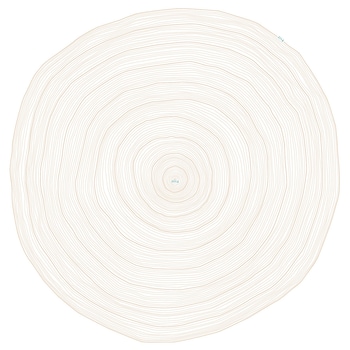
In Norway, it’s not unusual for time and territory to be thought of in a long-term way. There is, Paterson tells me, a hundred year-old mandate designed to ensure that the city of Oslo doesn’t encroach on Nordmarka forest. The Norwegian government is responsible for the Global Seed Vault in Svalbard, a gene bank for plants intended as insurance, essentially, against the apocalypse.
And around the time Paterson was configuring Future Library, scientists discovered that Norwegian trees had survived the Ice Age – at least two species were several thousand years older than was previously thought. For a promise made in Nordmarka, a hundred years was nothing.
“It didn’t throw the foresters sideways when this project came to them,” Paterson explains. “They think in hundred-year time-spans, because that’s their gauge of tree life. They really embraced it, and I trust them to look after these trees as they have the rest of the forest.”
However, one of the conundrums of Future Library is that it is only futuristic in the short term. In 2114, when the 100 books are published, the latest of them will have been written that same year, the previous one a year earlier, and so on. So the proposition is not the same for all writers. Atwood, Mitchell, Sjón and a few others know that they will not be alive to see their works meet the world, whereas the authors of 2100 won’t be part of a “future” library at all – they will be joining the past.
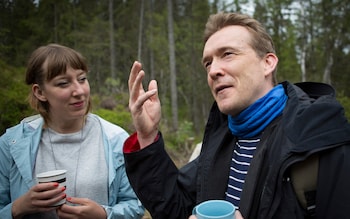
Romantic as the idea of a literary time capsule is, the “burial” aspect of the project is something of myth. In practice, the new Oslo City Library, scheduled for completion in 2019, will include a dedicated wood-lined space, in which the Future Library books will be kept sealed. In 2114, 3000 copies of each will be published, and if you have £600 to spare, you can buy an IOU for a full set now.
Is there a kind of writer to whom Paterson is drawn? With the addition of Sjón, one might begin to imagine that a qualifying writer is someone philosophical or playful enough to have conceived of Future Library himself. The words that keep coming up, Paterson says, are “imagination” and “time”.
One of the reasons she connects with Mitchell’s books Cloud Atlas and The Bone Clocks is “this projection through time zones and geography, through past, present and future – this delving into other worlds”. Both Mitchell and Atwood, the author of The Handmaid’s Tale, have what Paterson calls “a synergy with the idea of time”. No one has yet turned her down, though two writers she had in mind have died: The Name of the Rose author Umberto Eco and the Swedish Nobel winner Tomas Tranströmer.
Atwood compared Future Library to the tale of Sleeping Beauty. She also pointed out that no one really knows who they’ll be writing for anyway: all books, she said, are like “a message in a bottle”.
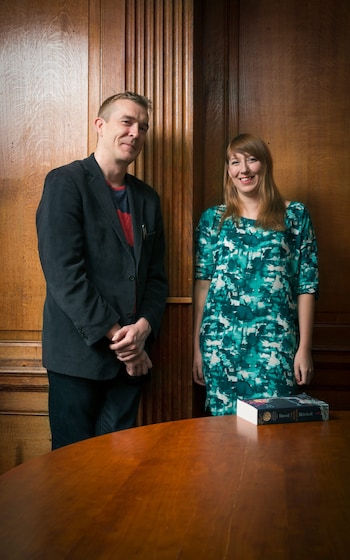
David Mitchell decided early on that he wouldn’t write with the future in mind. “I looked back to 100 years ago, and Conrad never bothered with that,” he says. “Woolf had no truck with that. HG Wells thought about the future a lot but he didn’t make allowances for what future readers may or may not know. Actually, fiction about the future is never really about the future – it’s using the extended elastic tether of the future to write about now.”
Mitchell did play a game with himself, just to keep his standards up: “Imagine this gets stolen and leaked on to the internet in five years’ time. Would I be ashamed of people reading it now?”
But other than that he was wary of making predictions. “Do you remember a TV show called Buck Rogers in the 25th Century?” he asks. “It was great, but wasn’t it ridiculous? Why do people wear sexy silver lycra in the future? It’ll be as big a style crime then as it is now! I suppose I didn’t want to do a textual version of that. The avant-garde never stays very ‘avant’ for long. It dates much more quickly, I think, than realism.”
The future does bring one benefit, though. Mitchell realised he could quote as many song lyrics as he liked without having to pay for them, because in 100 years’ time they’d be in the public realm. “So I’ve quoted from a Beatles song.”
Is it “Norwegian Wood”, by any chance?
“No, it’s ‘Here Comes the Sun’,” he says, then interrupts himself. “Oh! I wasn’t supposed to tell you that!”
For more information on Future Library, see futurelibrary.no